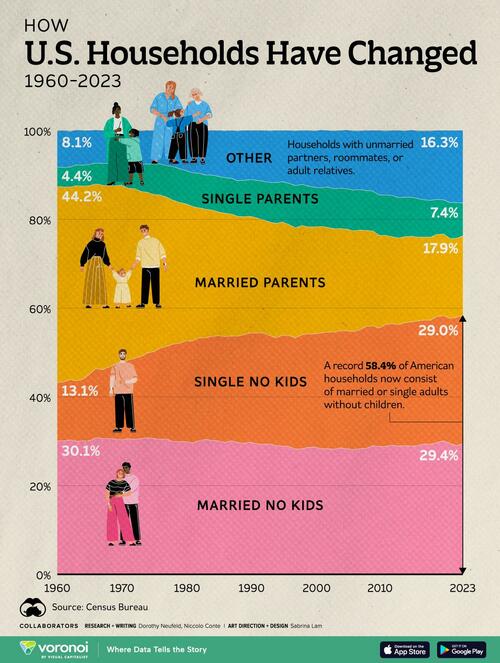How American Households Have Changed Over The Last 65 Years
The composition of American households has shifted significantly since 1960 as fewer people have kids and the scale of economic resources has declined.
Today, the number of households without kids exceeds those with kids, a trend that first emerged in 2014. In addition, single-person households have broadly continued to incline, reaching 29% of the total last year. This figure has more than doubled over the past six decades.
This graphic, via Visual Capitalist’s Dorothy Neufeld, shows the composition of American households over time, based on data from the Census Bureau via USAFacts.
Over Half of Households in the U.S. Don’t Have Kids
Below, we show the makeup of U.S. households from 1960 to 2023 at a time of rising costs, record home prices, and low fertility rates:
| Year | Married No Kids |
Single No Kids |
Married Parents |
Single Parents |
Other |
|---|---|---|---|---|---|
| 2023 | 29.4% | 29.0% | 17.9% | 7.4% | 16.3% |
| 2022 | 29.0% | 28.9% | 17.8% | 8.1% | 16.2% |
| 2021 | 29.5% | 28.2% | 18.0% | 8.1% | 16.2% |
| 2020 | 30.1% | 28.2% | 18.4% | 7.7% | 15.6% |
| 2019 | 29.7% | 28.4% | 18.5% | 7.9% | 15.5% |
| 2018 | 29.3% | 28.0% | 18.7% | 8.3% | 15.6% |
| 2017 | 29.4% | 27.9% | 18.7% | 8.4% | 15.5% |
| 2016 | 29.0% | 28.1% | 18.9% | 8.7% | 15.2% |
| 2015 | 28.9% | 28.0% | 19.3% | 8.8% | 15.1% |
| 2014 | 29.0% | 27.7% | 19.4% | 8.9% | 14.9% |
| 2013 | 28.9% | 27.4% | 19.5% | 9.1% | 15.1% |
| 2012 | 29.1% | 27.4% | 19.6% | 9.3% | 14.6% |
| 2011 | 28.8% | 27.5% | 20.1% | 9.1% | 14.4% |
| 2010 | 28.8% | 26.7% | 20.9% | 9.1% | 14.5% |
| 2009 | 29.0% | 27.0% | 21.4% | 9.0% | 13.6% |
| 2008 | 28.4% | 27.5% | 21.6% | 9.0% | 13.5% |
| 2007 | 28.3% | 26.8% | 22.5% | 9.1% | 13.2% |
| 2006 | 28.1% | 26.6% | 22.7% | 9.2% | 13.3% |
| 2005 | 28.3% | 26.6% | 22.9% | 9.1% | 13.2% |
| 2004 | 28.5% | 26.4% | 23.0% | 9.1% | 13.0% |
| 2003 | 28.2% | 26.4% | 23.3% | 9.0% | 13.0% |
| 2002 | 28.3% | 26.3% | 23.6% | 9.1% | 12.7% |
| 2001 | 28.3% | 26.1% | 24.0% | 8.7% | 13.0% |
| 2000 | 28.7% | 25.5% | 24.1% | 8.9% | 12.7% |
| 1999 | 28.6% | 25.6% | 24.1% | 9.2% | 12.5% |
| 1998 | 28.3% | 25.7% | 24.6% | 9.3% | 12.1% |
| 1997 | 28.2% | 25.1% | 24.8% | 9.5% | 12.3% |
| 1996 | 28.8% | 25.0% | 25.0% | 9.3% | 11.9% |
| 1995 | 28.9% | 25.0% | 25.5% | 9.1% | 11.5% |
| 1994 | 29.0% | 24.3% | 25.8% | 9.2% | 11.7% |
| 1993 | 29.4% | 24.4% | 25.6% | 8.9% | 11.6% |
| 1992 | 29.3% | 25.1% | 25.5% | 8.7% | 11.4% |
| 1991 | 29.4% | 25.0% | 25.9% | 8.5% | 11.2% |
| 1990 | 29.8% | 24.6% | 26.3% | 8.3% | 11.0% |
| 1989 | 29.5% | 24.5% | 26.6% | 8.2% | 11.2% |
| 1988 | 29.7% | 24.0% | 27.0% | 8.0% | 11.2% |
| 1987 | 30.1% | 23.6% | 27.5% | 8.1% | 10.7% |
| 1986 | 29.7% | 23.9% | 27.8% | 8.0% | 10.5% |
| 1985 | 30.1% | 23.7% | 27.9% | 8.0% | 10.3% |
| 1984 | 30.2% | 23.4% | 28.5% | 7.9% | 10.0% |
| 1983 | 30.4% | 22.9% | 29.0% | 7.7% | 9.9% |
| 1982 | 30.1% | 23.2% | 29.3% | 7.8% | 9.6% |
| 1981 | 29.6% | 23.0% | 30.3% | 7.6% | 9.5% |
| 1980 | 29.9% | 22.7% | 30.9% | 7.5% | 9.0% |
| 1979 | 29.9% | 22.2% | 31.7% | 7.6% | 8.5% |
| 1978 | 29.9% | 22.0% | 32.4% | 7.6% | 8.2% |
| 1977 | 30.5% | 20.9% | 33.6% | 7.1% | 7.9% |
| 1976 | 30.4% | 20.6% | 34.5% | 7.0% | 7.6% |
| 1975 | 30.6% | 19.6% | 35.4% | 6.9% | 7.5% |
| 1974 | 30.8% | 19.1% | 36.2% | 6.4% | 7.5% |
| 1973 | 30.6% | 18.5% | 37.2% | 6.1% | 7.5% |
| 1972 | 30.4% | 18.3% | 38.2% | 5.9% | 7.2% |
| 1971 | 30.6% | 17.7% | 38.7% | 5.7% | 7.3% |
| 1970 | 30.3% | 17.1% | 40.3% | 5.2% | 7.1% |
| 1969 | 30.5% | 16.7% | 40.4% | 5.2% | 7.3% |
| 1968 | 30.6% | 16.1% | 40.9% | 5.0% | 7.3% |
| 1967 | 30.6% | 15.5% | 41.6% | 4.9% | 7.4% |
| 1966 | 30.8% | 15.6% | 41.6% | 4.7% | 7.4% |
| 1965 | 30.1% | 15.0% | 42.5% | 4.8% | 7.6% |
| 1964 | 30.1% | 13.9% | 43.5% | 4.7% | 7.8% |
| 1963 | 30.0% | 13.6% | 44.0% | 4.7% | 7.8% |
| 1962 | 30.3% | 13.6% | 43.4% | 4.5% | 8.0% |
| 1961 | 30.1% | 13.3% | 43.9% | 4.4% | 8.3% |
| 1960 | 30.1% | 13.1% | 44.2% | 4.4% | 8.1% |
Other represents households with unmarried partners, roommates, or adult relatives.
In 1960, the share of U.S. households that consisted of married parents was 44.2%, which has since dropped by half as of 2023.
More Americans today are delaying or forgoing marriage altogether, with just 20% of women and 23% of men aged 25 being married—the lowest on record. Projections indicate that by 2050, one-third of Americans aged 45 may remain unmarried.
Meanwhile, households consisting of single parents or individuals living alone have doubled over this period, coinciding with the U.S. fertility rate falling to a historic low of 1.6 children per woman in 2023, well below the 2.1 replacement level needed for population stability.
Personal preference plays a significant role in changing attitudes toward parenthood. Among Americans under 50 without children, 57% said they simply didn’t want kids, while 44% preferred to focus on other priorities. Financial concerns also weighed heavily, with 36% citing the cost of raising children—three times the rate among childless people over 50.
Last year, just 16% of homes in America were considered affordable as mortgage rates more than doubled since 2021. This represents a sharp decline from 2013, when 50% of homes were affordable—a shift that is likely shaping household dynamics as rising costs influence Americans’ future choices.
To learn more about this topic from a global perspective, check out this graphic on the countries with the lowest fertility rates in the world.
Tyler Durden Thu, 11/07/2024 – 05:45
Source: https://freedombunker.com/2024/11/07/how-american-households-have-changed-over-the-last-65-years/
Anyone can join.
Anyone can contribute.
Anyone can become informed about their world.
"United We Stand" Click Here To Create Your Personal Citizen Journalist Account Today, Be Sure To Invite Your Friends.
Before It’s News® is a community of individuals who report on what’s going on around them, from all around the world. Anyone can join. Anyone can contribute. Anyone can become informed about their world. "United We Stand" Click Here To Create Your Personal Citizen Journalist Account Today, Be Sure To Invite Your Friends.
LION'S MANE PRODUCT
Try Our Lion’s Mane WHOLE MIND Nootropic Blend 60 Capsules
Mushrooms are having a moment. One fabulous fungus in particular, lion’s mane, may help improve memory, depression and anxiety symptoms. They are also an excellent source of nutrients that show promise as a therapy for dementia, and other neurodegenerative diseases. If you’re living with anxiety or depression, you may be curious about all the therapy options out there — including the natural ones.Our Lion’s Mane WHOLE MIND Nootropic Blend has been formulated to utilize the potency of Lion’s mane but also include the benefits of four other Highly Beneficial Mushrooms. Synergistically, they work together to Build your health through improving cognitive function and immunity regardless of your age. Our Nootropic not only improves your Cognitive Function and Activates your Immune System, but it benefits growth of Essential Gut Flora, further enhancing your Vitality.
Our Formula includes: Lion’s Mane Mushrooms which Increase Brain Power through nerve growth, lessen anxiety, reduce depression, and improve concentration. Its an excellent adaptogen, promotes sleep and improves immunity. Shiitake Mushrooms which Fight cancer cells and infectious disease, boost the immune system, promotes brain function, and serves as a source of B vitamins. Maitake Mushrooms which regulate blood sugar levels of diabetics, reduce hypertension and boosts the immune system. Reishi Mushrooms which Fight inflammation, liver disease, fatigue, tumor growth and cancer. They Improve skin disorders and soothes digestive problems, stomach ulcers and leaky gut syndrome. Chaga Mushrooms which have anti-aging effects, boost immune function, improve stamina and athletic performance, even act as a natural aphrodisiac, fighting diabetes and improving liver function. Try Our Lion’s Mane WHOLE MIND Nootropic Blend 60 Capsules Today. Be 100% Satisfied or Receive a Full Money Back Guarantee. Order Yours Today by Following This Link.







